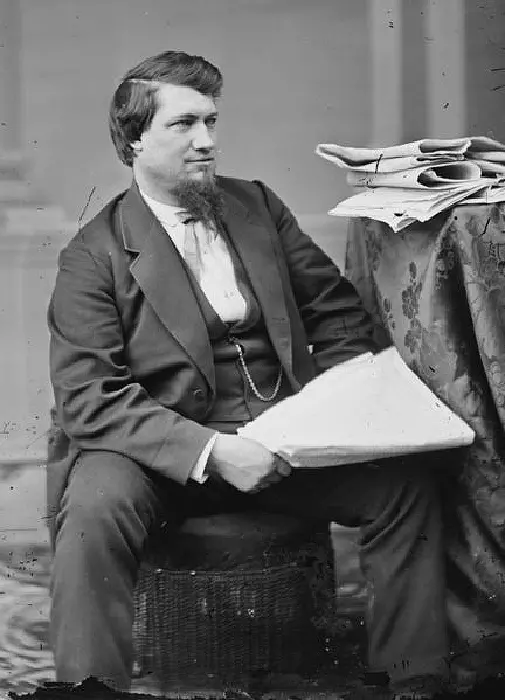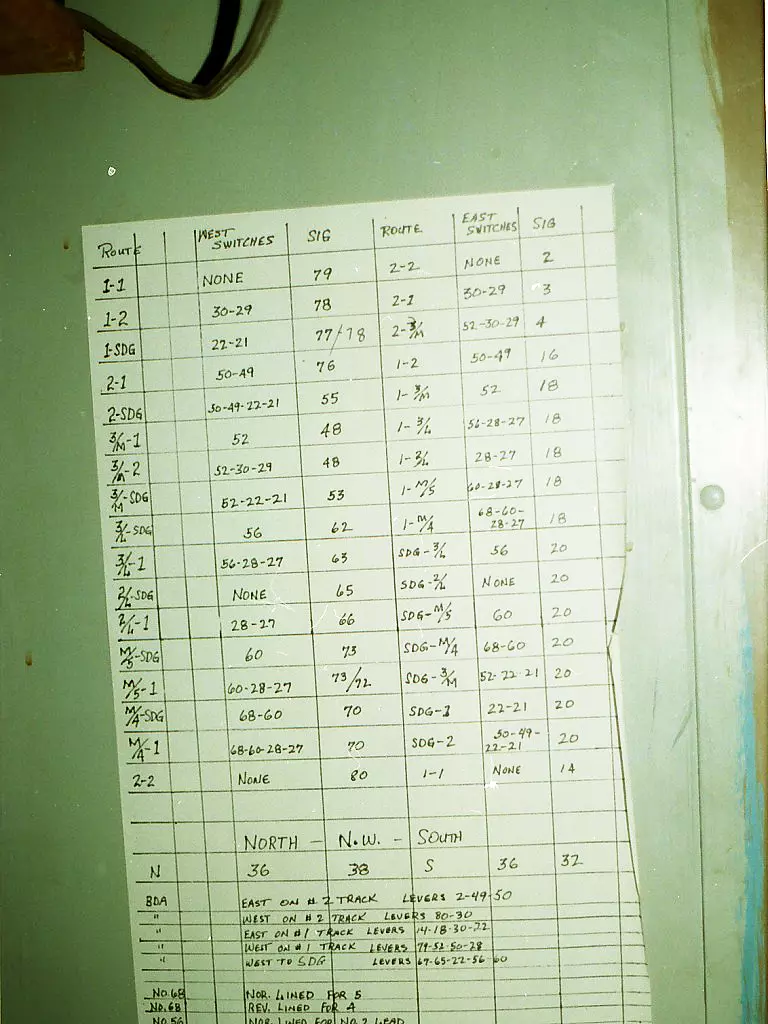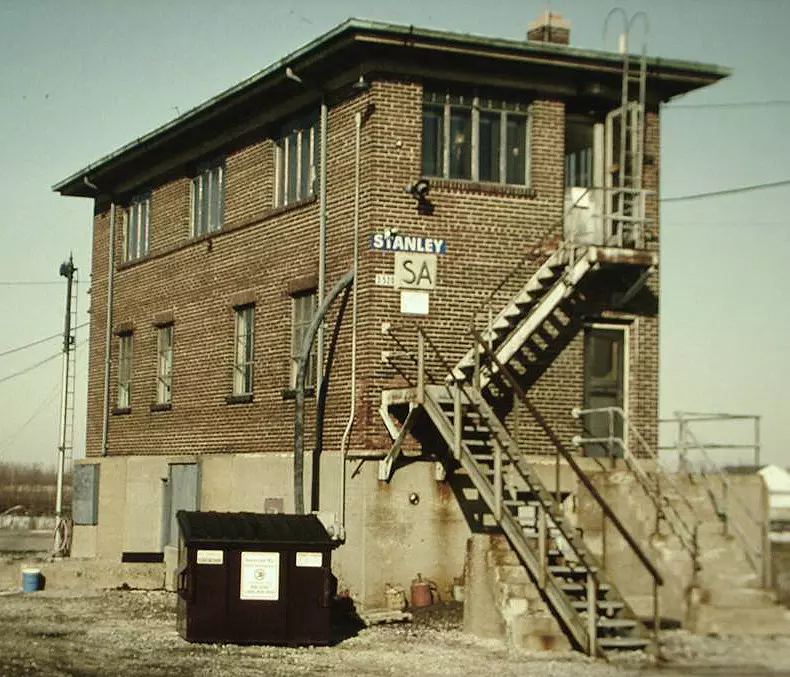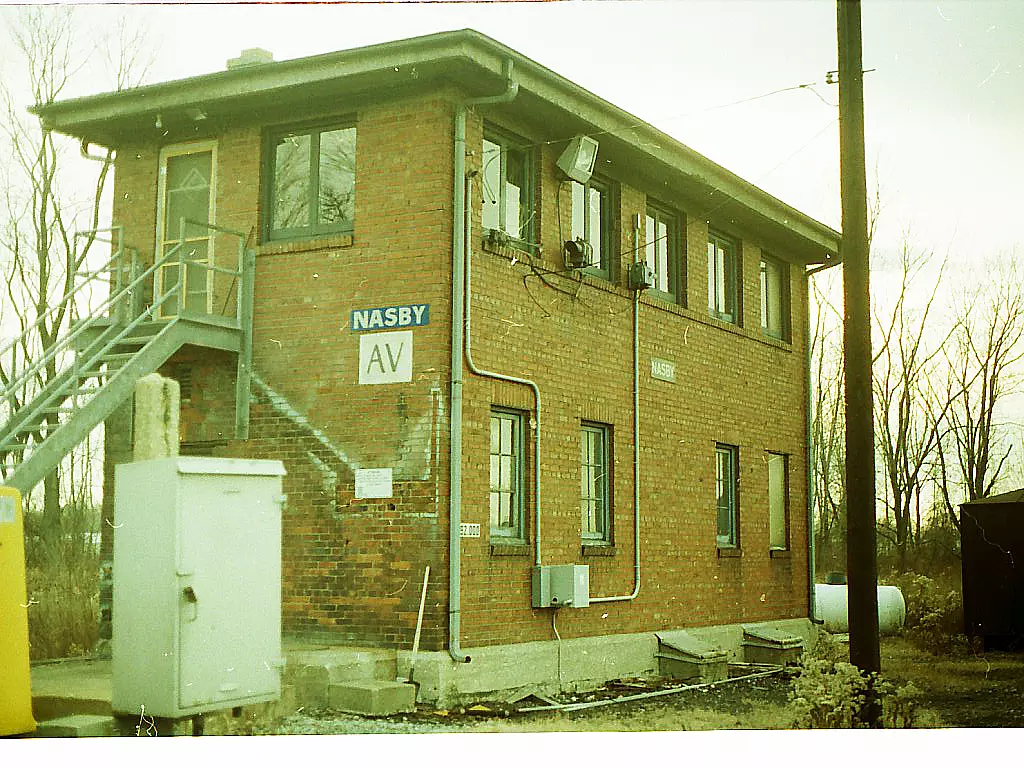 Nasby Interlocking Tower
Nasby Interlocking Tower
Exhibit Gallery






















By Greg Johnson and John Ehrmin
This exhibit, donated by John Ehrmin of Toledo, is a brief photographic essay on the former Nasby Interlocking Tower, which ended its operations on March 22, 1998. The essays on Petroleum V. Nasby and David Ross Locke were written by Greg Johnson.
 Conrail’s Nasby Interlocking Tower (Control Point CP 292- milepost))
Conrail’s Nasby Interlocking Tower (Control Point CP 292- milepost))
March 22, 1998 at 7:00 a.m. was the end of over 57 years of service for Conrail’s Nasby Interlocking Tower (Control Point CP 292- milepost) in its present form.
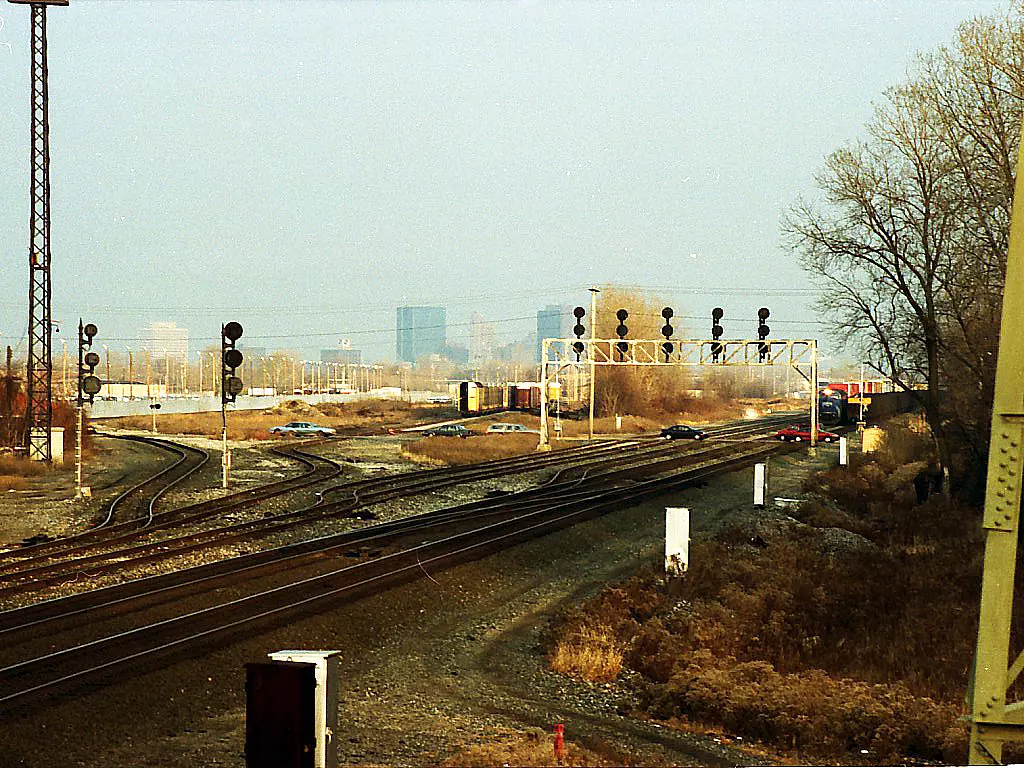 East-west Conrail main line, view from tower steps, Photo 3
East-west Conrail main line, view from tower steps, Photo 3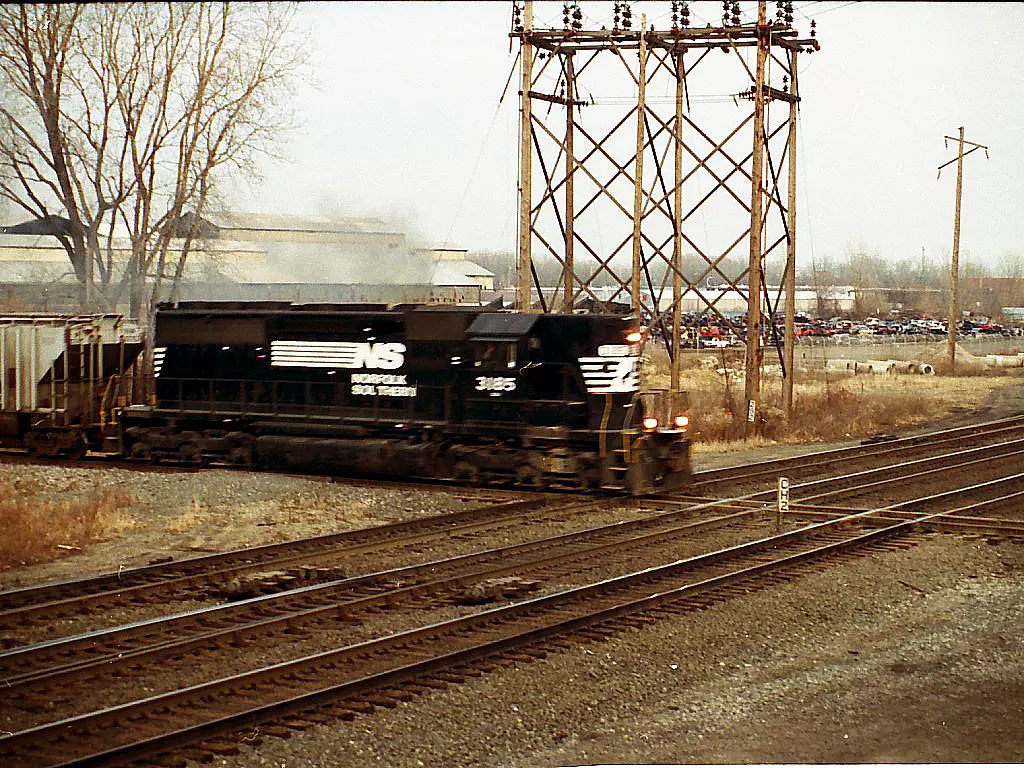 TTRR crossing with crossovers between the mains, Photo 2
TTRR crossing with crossovers between the mains, Photo 2
Nasby Station
Nasby Tower was at the intersection of the Toledo Terminal Railroad (TTRR) and the east-west Conrail main line (Photos 2 and 3 above – view from tower steps). The tower controlled the TTRR crossing, several tracks into the west end of the old Air Line Yard (now an intermodal terminal), a branch main to Detroit, a long siding to the west, and crossovers between the mains (Photo 2 directly above - looking east from the tower).
The second floor was where the action was. The first floor was filled with wiring, relays, and back-up batteries.
The operator had a desk facing the tracks and windows to view all the action (Photo 4). He had radios, a telephone, a fax machine, and a clock. His main job was to operate the switch machine (Photo 5), but he also called cabs to move train crews, handed up the daily bulletin and any special written orders to train crews, and recorded all the activity on a train sheet. Most of the second floor was the switch machine in a big wood case. A long row of black and white handles along the left side controlled the switches and signals
The red tubes were put on the handles if there was a malfunction (Photos 5). A track diagram is on the wall to the right. The original interlocking diagram and subsequent changes had obviously not been done by graphics experts. The silver stripe from top to bottom was probably pasted on when the Toledo Terminal was reduced from two tracks to one (Photo 6). Other tracks removed have been covered with black tape. Closer views show a close-up of some handles on the switch machine (Photo 9).
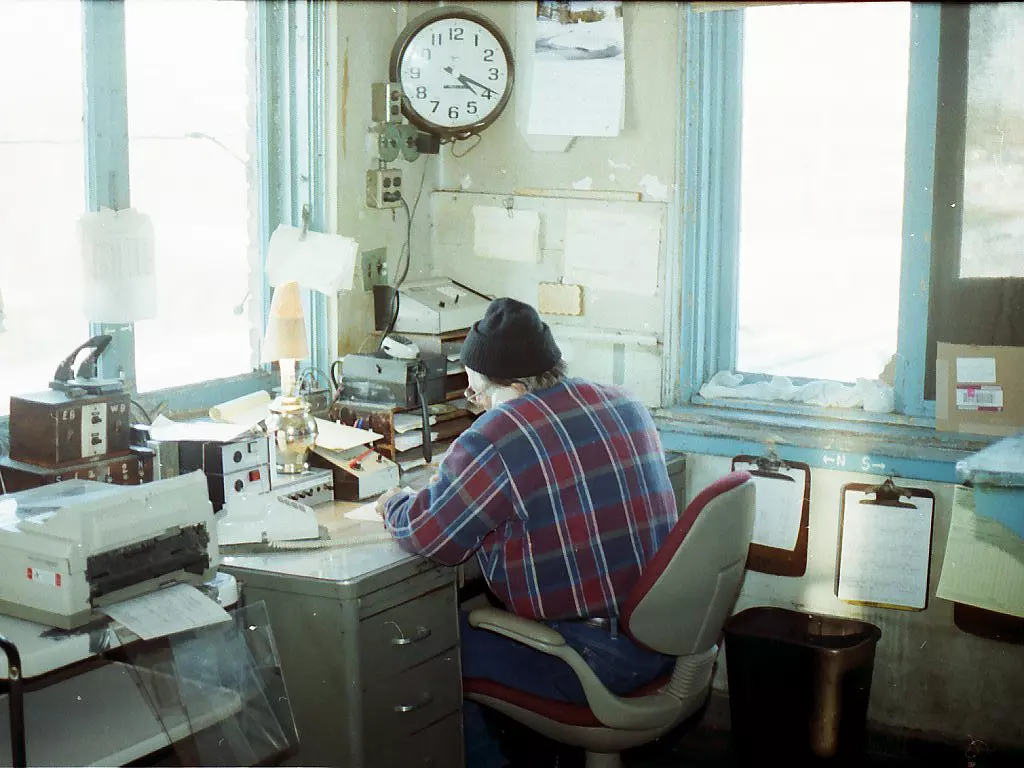 Operator's Office on the second floor, Photo 4
Operator's Office on the second floor, Photo 4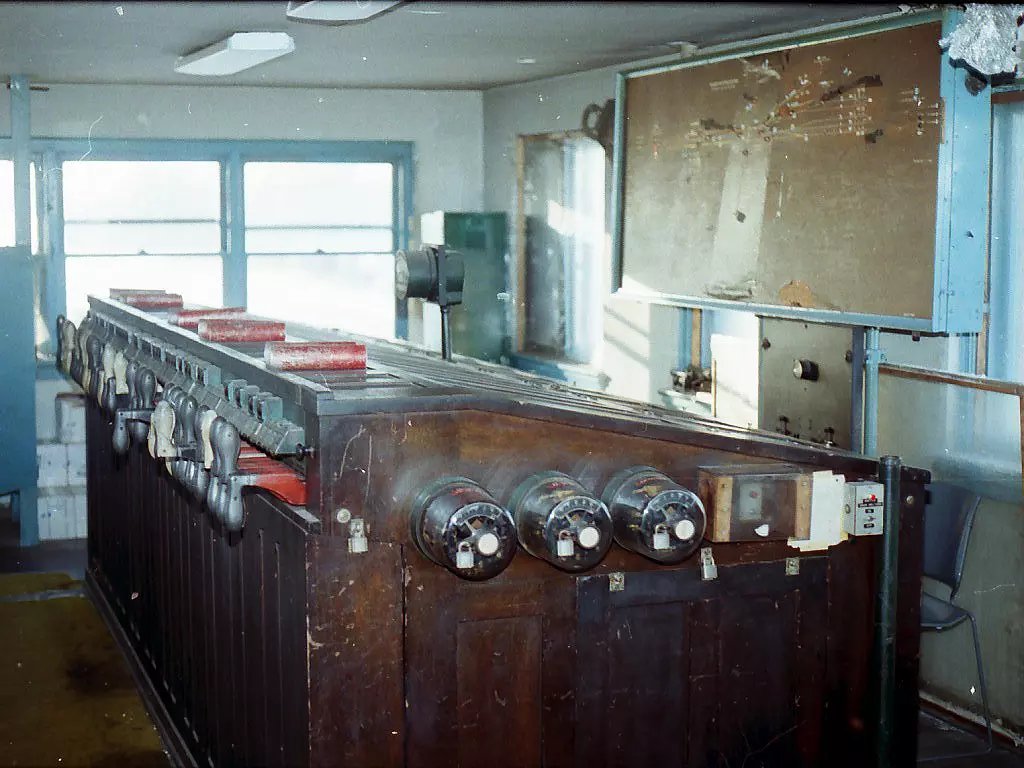 Switch Machine, Photo 5
Switch Machine, Photo 5
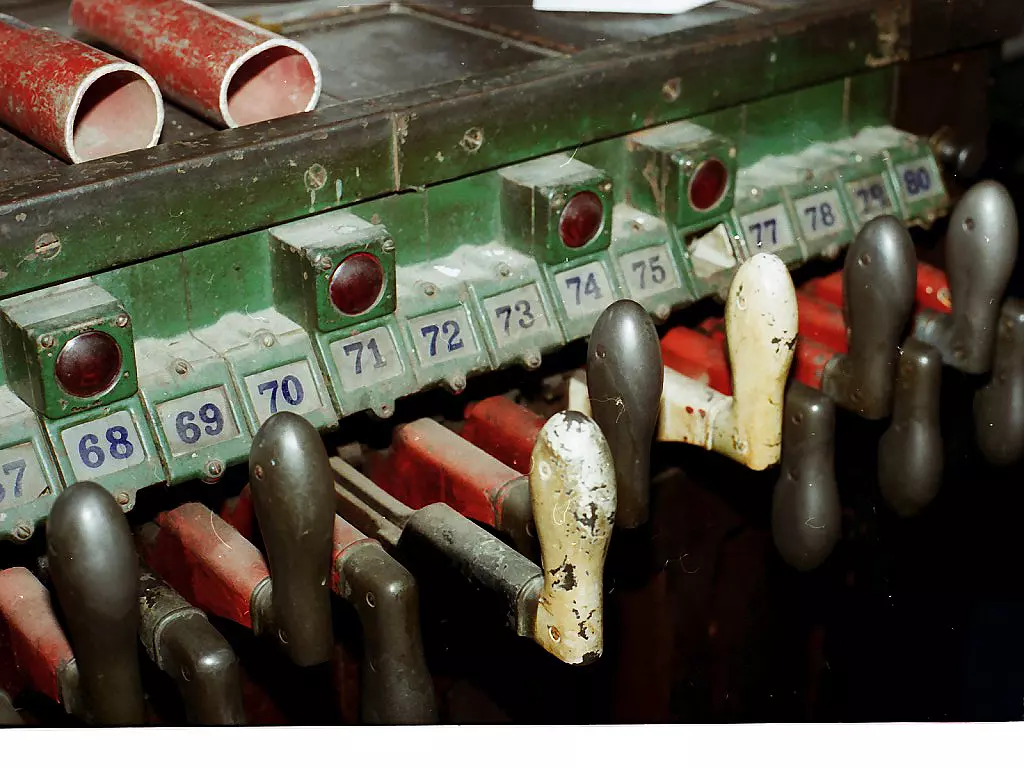 Black and white handles controlling the switches and signals, Photo 9
Black and white handles controlling the switches and signals, Photo 9
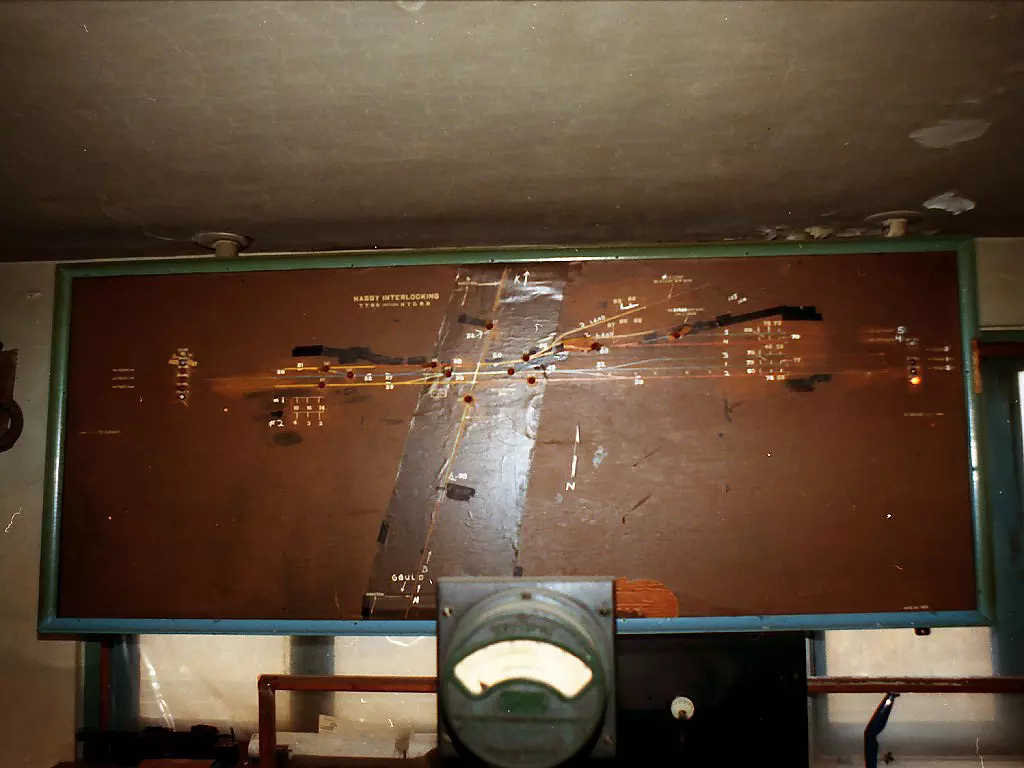 Switch Machine with interlocking diagram, Photo 6
Switch Machine with interlocking diagram, Photo 6
The Nasby Tower Environs
 East-west Conrail main line, view from tower steps, Photo 3
East-west Conrail main line, view from tower steps, Photo 3
It is said that Nasby Tower was named for Petroleum V. Nasby, a Civil War cartoon figure created by David Ross Locke, a former Toledo newspaper editor and mayor. The real reason for naming the tower Nasby is lost to history.
Nasby Interlocking controlled the crossing of the west side of the Toledo Terminal and Conrail. There is no connection from Conrail to the Terminal tracks, although there once was. The Toledo Terminal track was used solely by the Norfolk Southern for access to grain terminals on the south side of Toledo from their Homestead yard in East Toledo and usually had one train down and one train back each day.
Nasby also controlled crossovers in both directions between the two east-west mainlines. It was also at the west end of a large Y. The east end of the Y is at the former location of the Swan creek Tower CP-289. The east-west mains form the south side of the Y. The two Conrail mains to Detroit form the east leg of the Y and the west leg is formed by a single track from the Detroit mains for traffic from Detroit going west. This track, called 3 lead, enters the east-west mains at Nasby. There is also a siding north of track #1 which goes west to Holland at CP-295.
Petroleum V. Nasby
David Ross Locke, a former editor of the Toledo Blade, created the fictional character Petroleum Vesuvius Nasby, a mostly illiterate, foul, and bigoted Southerner who would do anything to get a Postmasters job, as a vehicle to a satirical look at the Civil War and the Reconstruction Period. Locke's creation was quite fond of using Bible text to support his positions on slavery and other Southern causes. One admirer of the Nasby letters was President Abraham Lincoln, who would often quote the letters verbatim.
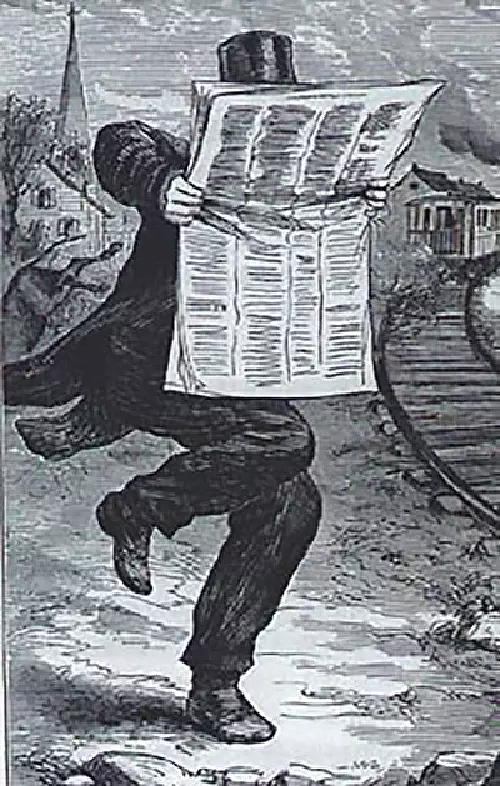 Petroleum versus Nasby political cartoon
Petroleum versus Nasby political cartoon
After the war ended, Locke would continue to write the Nasby Letters during the Reconstruction period, commenting on the time period as Nasby slinked off with other former Southern soldiers for adventures that acted as commentary on the reconstruction of the South. The moral, hard working characters were all Republicans, while the characters that were drunken, lazy, or unwilling to repay their debts were usually former Southern soldiers or Nasby himself.
Petroleum v. Nasby, Toledo Blade, Vol. LXV: No. 10 (Thursday, February 25, 1897 [article link]
David Ross Locke
Petroleum V. Nasby was the pseudonym of Davis Ross Locke, the popular Civil War political satirist and Toledo Blade editor. Locke, originally from Vestal, New York, began his newspaper career at the early age of 10, apprenticing at the Courtland County, New York newspaper the Democrat.
After his seven-year apprenticeship, Locke began to ply his trade professionally. He began his career with the Pittsburgh Chronicle, later moving on to the Plymouth Ohio Herald, an editor position at the Bucyrus Journal in Bucyrus, Ohio, and finally taking an editor’s position at the Toledo Blade.
It was as the editor of the Blade that Locke, an ardent supporter of ending slavery in the south, created the character Petroleum V. Nasby, a rude, Southern caricature of the popular Northern opinion of the South. Locke would write the Nasby Letters for the next 20 years, commenting on the Civil War and the Reconstruction period.
Locke continued to be a leader within the Toledo community, eventually purchasing the Blade in 1876. After a short stint as the editor of the New York Evening Mail, Locke eventually moved back to Toledo and took an Alderman position in the Third War of Toledo. Locke would spend his final years in Toledo, eventually succumbing to Tuberculosis in 1888.
Nasby Operating Details
The following details are now history, but the dispatcher still has to provide the same operating functions that the tower operators provided. Nasby is not a large complicated plant, but it is still interesting and does have a few challenges.
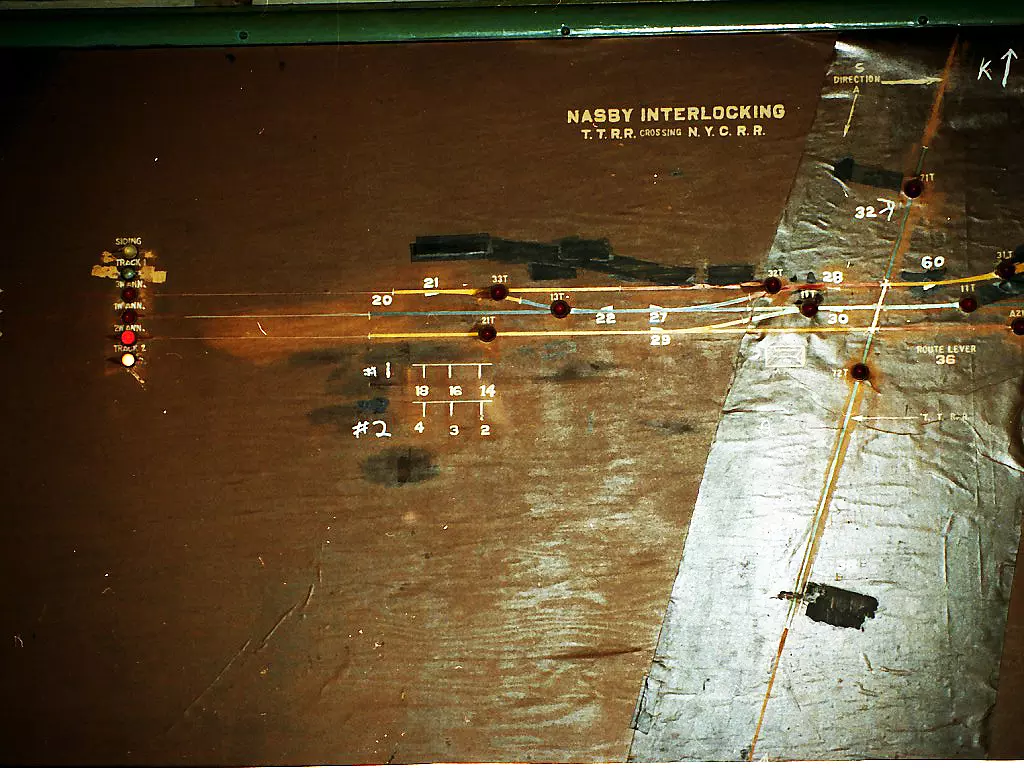 Close-up view of the interlocking diagram, left side, Photo 7
Close-up view of the interlocking diagram, left side, Photo 7
The track diagram had a number of features. The tracks, switches, and signal locations were all shown (Photos 7 and 8). The numbers for switches and signals were intermingled and started low at the west end and increased to the east. For example, on the east end, the signal bridge in Photo 3 with five to three signal stacks, the #2 main signals are numbers 55, 76, and 80. The westbound crossover switches from #2 main to #1 main were numbers 50 and 49. At either end of the track diagram, the #1 and #2 tracks and the siding had white lights. These lights were lit when a train was lined into the plant by the dispatcher. When a train entered the plant, a buzzer sounded and the red light next to the white light was lit. Red lights in track segments showed when a segment was occupied. A route could not be changed to a conflicting route until the train cleared the whole plant. If a route was set and the dispatcher changed his mind, it was necessary to set a timer at the end of the machine to clear the route. This would take 4 minutes.
Of course, the purpose of the plant was to prevent switch and signal settings that could result in a collision or derailment. It was possible, however, to have multiple movements as long as routes were mutually exclusive.
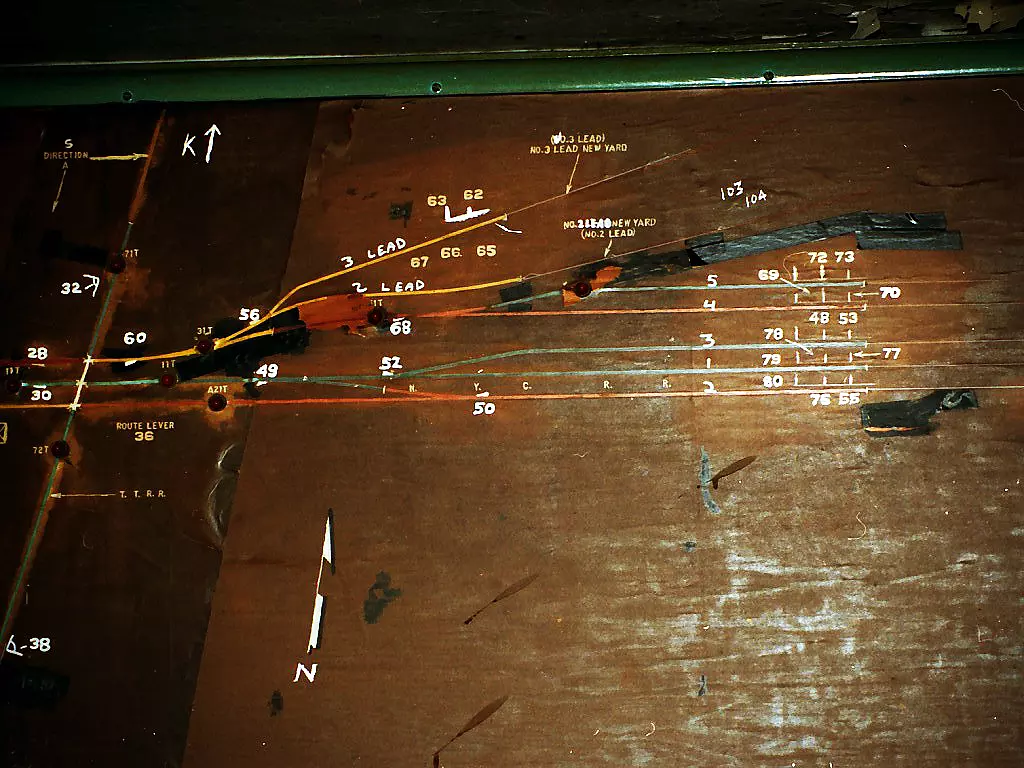 Interlocking diagram, right side, Photo 8
Interlocking diagram, right side, Photo 8
A study of the track diagram and the instruction list gives insight into the many possible movements. The bottom track is the #2 main. The next track up is the #1 main. The dispatchers use both tracks in both directions, although #2 tends to be eastbound and #1 tends to be westbound. The east end of Nasby territory started at Westwood Ave. (visible in (Photo 3). This was once a seventeen-track street crossing, but is now down to 7 tracks. The #3 track is a siding which starts at Swan Creek and goes west to CP-295. #4 and #5 tracks enter the Mega-Terminal facility from Nasby on the west and from #3 track from the east. The #2 lead goes into the automobile loading facility. The #3 lead, as previously mentioned, connects to the Detroit mainline.
On the west end of the plant there is just a third track called the siding. Trains from Detroit can go west only on track #1 or the siding and conversely eastbound trains to Detroit must be on track #1 or the siding. The dispatchers tend to route trains to Detroit onto the siding out farther west but it is still necessary for trains to cross from #2 to #1 and then to the siding which, disrupts the westbound use of #1. A quirk of the plant is that it is not possible to go to Detroit from Track #2 because the crossover from #2 to #1 is east of the crossover from #1 to #3 lead.
Lining up a Route
This required pulling the handles for switches 56, 28, and 27 (Photo 11). The switch handle was initially pulled mostly but not all the way. The ammeter on top of the machine showed power going to the switch motor as a surge in amps. When the switch was fully reversed, a click was heard and then it was possible to finish pulling the handle. If there was a problem with the switch machine, a maintainer would be called to make a repair.
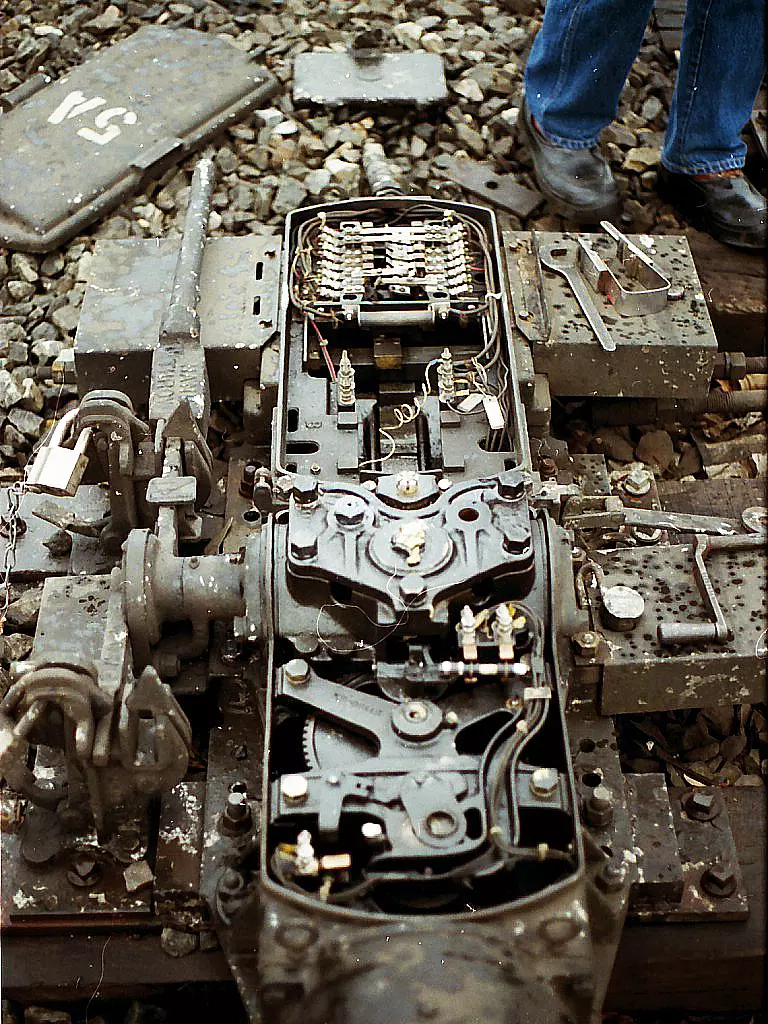 Switches 56, 28, and 27, Photo 11
Switches 56, 28, and 27, Photo 11
Signal handle 63 was pulled last and if all interlocking conditions were satisfied, the route lights at each handle involved with the route would light, as would the appropriate track signal.
Observation March 28, 1997
I spent several enjoyable hours at Nasby observing fairly heavy traffic on this day. I saw some foreign power as well. Many interesting power combinations are occurring these days. It was not uncommon to see CSX, NS, BN, UP, CNW, Santa Fe engines, often mixed and often in consists with Conrail locomotives.
A westbound multi-level train was dropping off cars at the Mega-Terminal (Photo 12). The rear part of this train had been left on main track #1. Unfortunately, the cars on #1 were too far west to allow for backing the engine back down onto the train and still be clear to the east of the interlocking. This delayed the train because all other traffic had to clear before time could be taken for the brake test. Cars for Toledo were dropped on track #5. During this move a westbound freight went by (Photo 13).
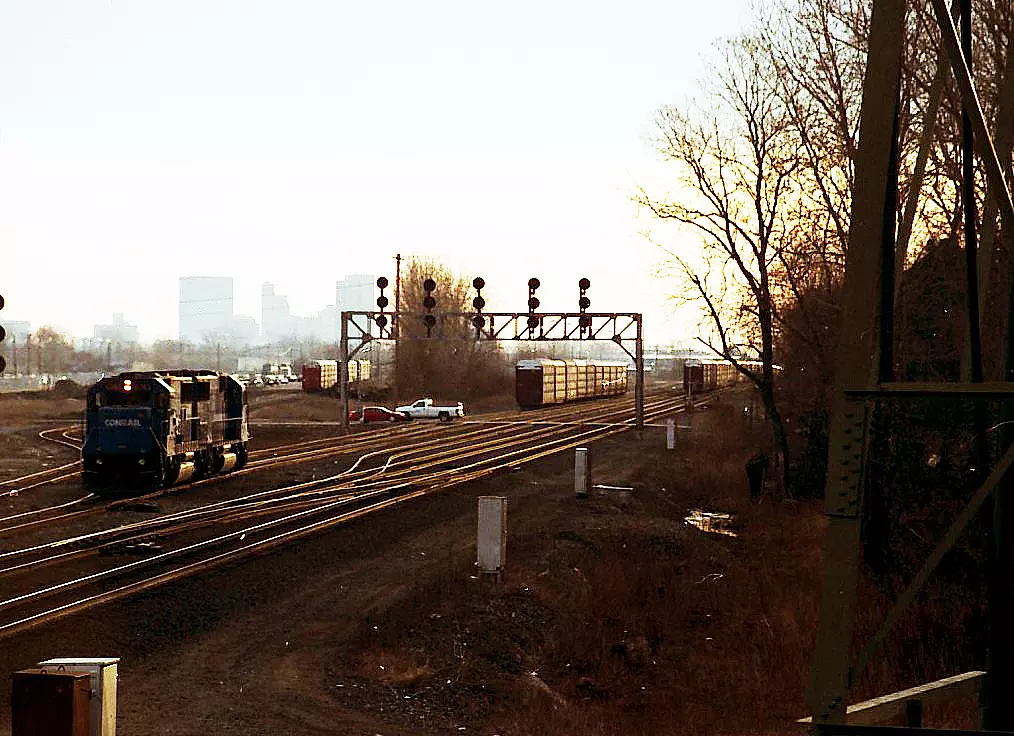 Westbound multi-level train dropping off cars at the Mega-Terminal, Photo 12
Westbound multi-level train dropping off cars at the Mega-Terminal, Photo 12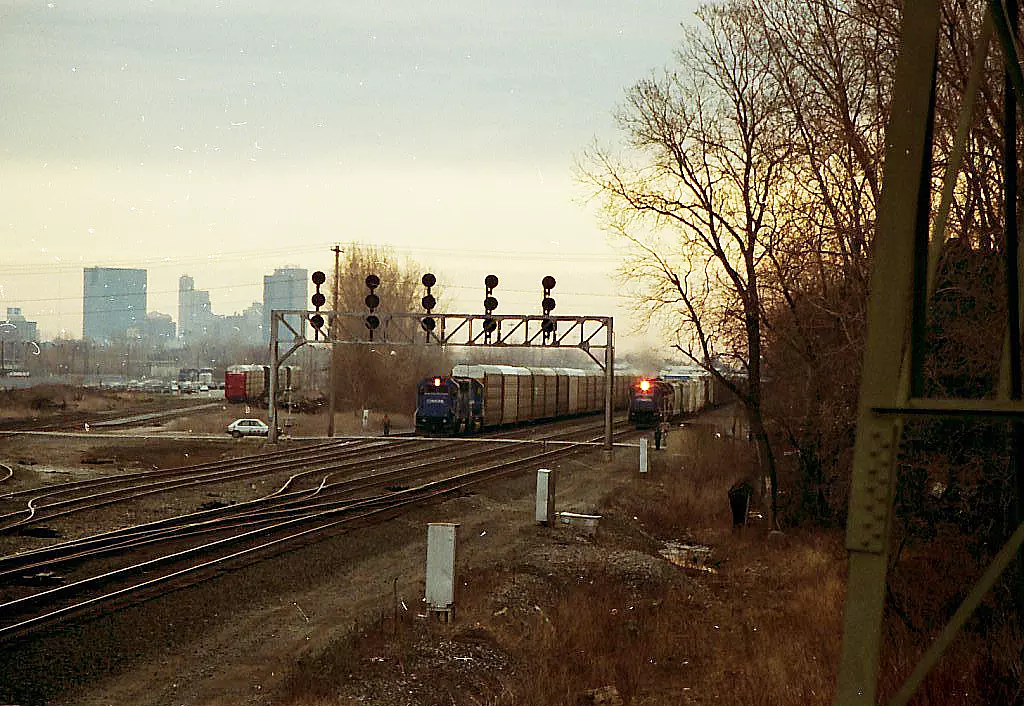 Westbound freight train going by the maneuver, Photo 13
Westbound freight train going by the maneuver, Photo 13
Next, an eastbound TV train crossed from #1 main to track #3 to drop and add cars farther east in the Mega-Terminal (Photo 14). This train had a CSX engine in between two Conrail engines.
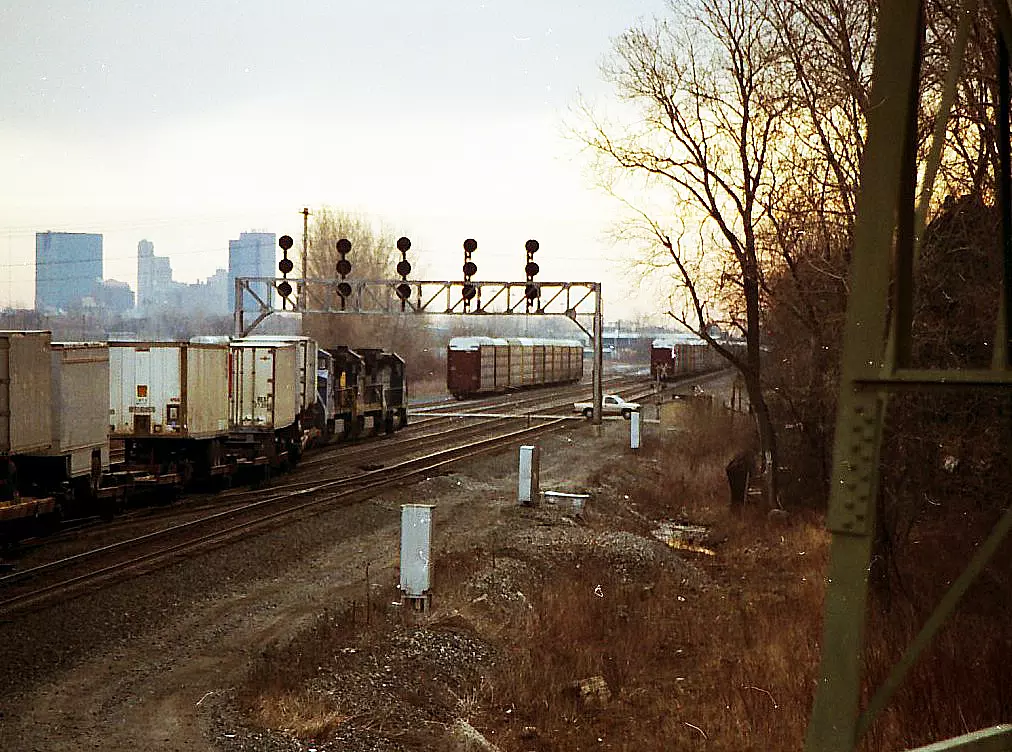 Eastbound TV train headed for the Mega-terminal, Photo 14
Eastbound TV train headed for the Mega-terminal, Photo 14
Another westbound freight appeared and was crossed from #2 main to #1 main (Photo 15). It was passing the multilevel cars sitting on #1 and had to cross back to #2 because there were two eastbound trains on #2 sitting west of Nasby waiting to go east. This train had a Conrail engine on the point with HLCX #6069 and UP #3365 trailing.
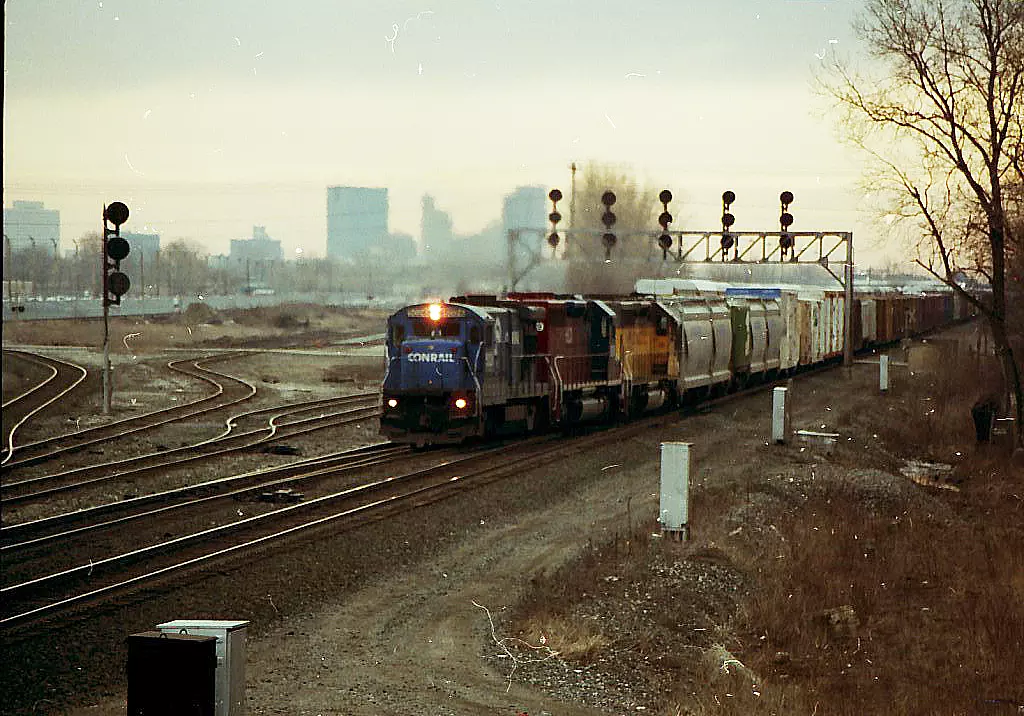 Westbound freight with a Conrail engine, Photo 15
Westbound freight with a Conrail engine, Photo 15
Next, an eastbound double-stack container train appeared (Photo 16). Another multilevel train can be seen heading up 3 lead to Detroit at the same time. This train came east on the siding.
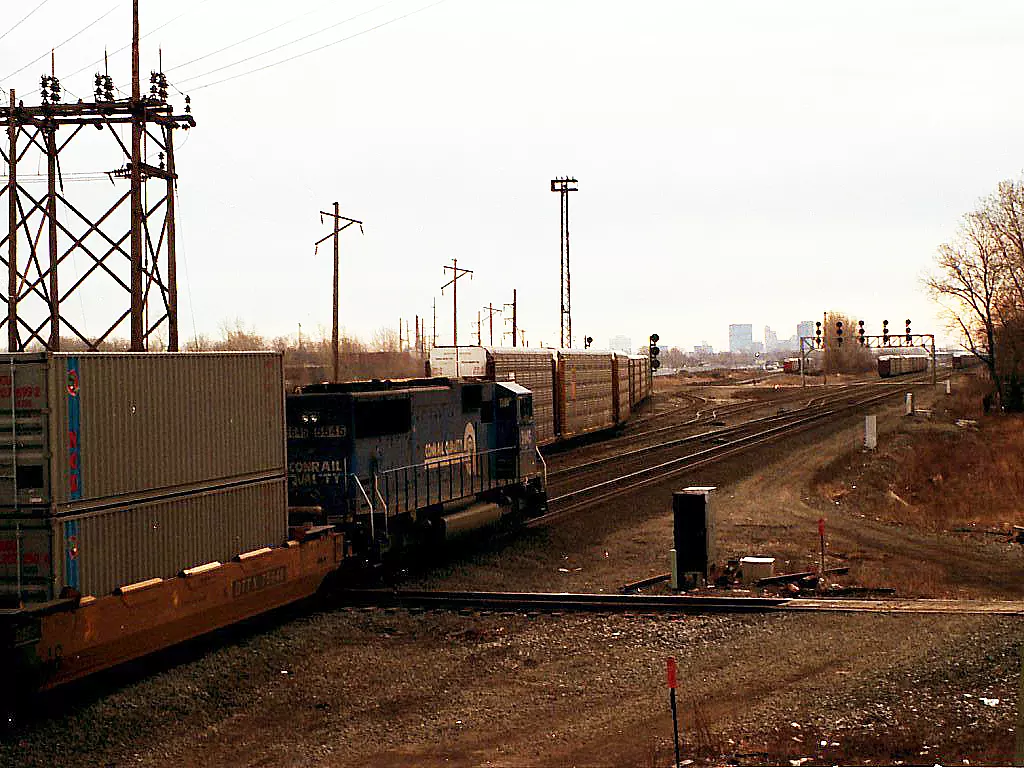 Eastbound double-stack container train appeared , Photo 16
Eastbound double-stack container train appeared , Photo 16
Shortly after the double-stack train cleared, another west bound freight appeared, crossing from #2 to #1 (Photo #17). Note the maintenance truck in the foreground. He was either fixing a switch machine or tightening bolts on the crossing diamonds.
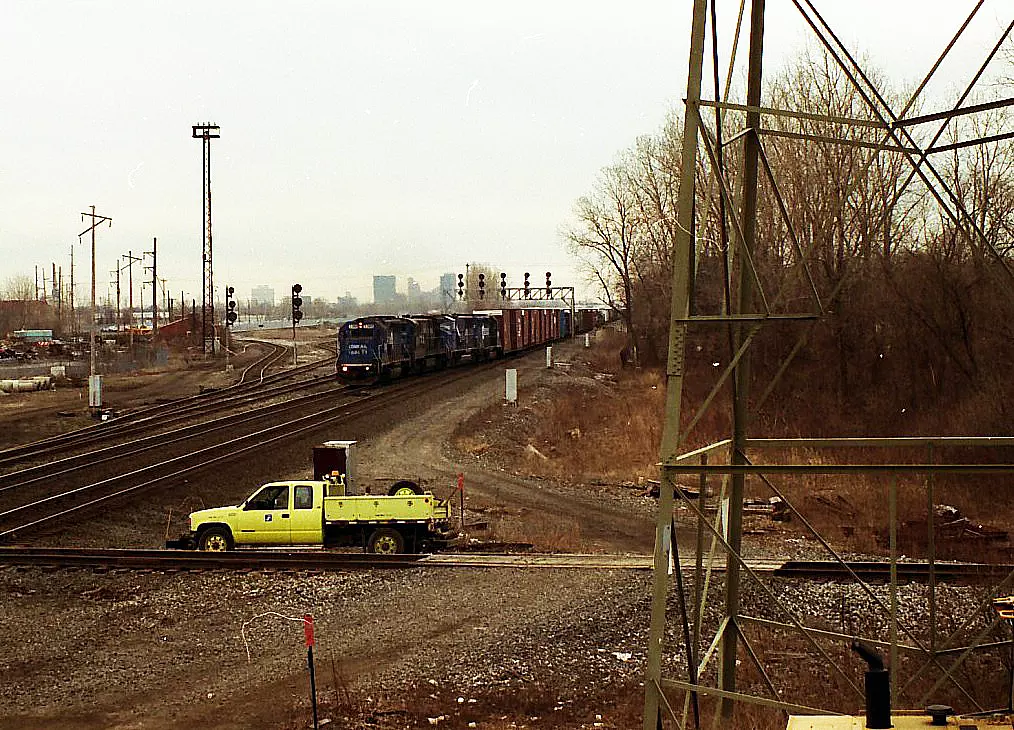 Westbound train and maintenance truck, Photo 17
Westbound train and maintenance truck, Photo 17
Following the freight train was a late Amtrak, probably the Lake Shore Limited (Photo 18). This engineer was probably not too happy since he was following two 50 mph trains. The Amtrak speed limit west of Toledo is 79 mph. It was probably passed around those freights when the eastbound trains were cleared from the west.
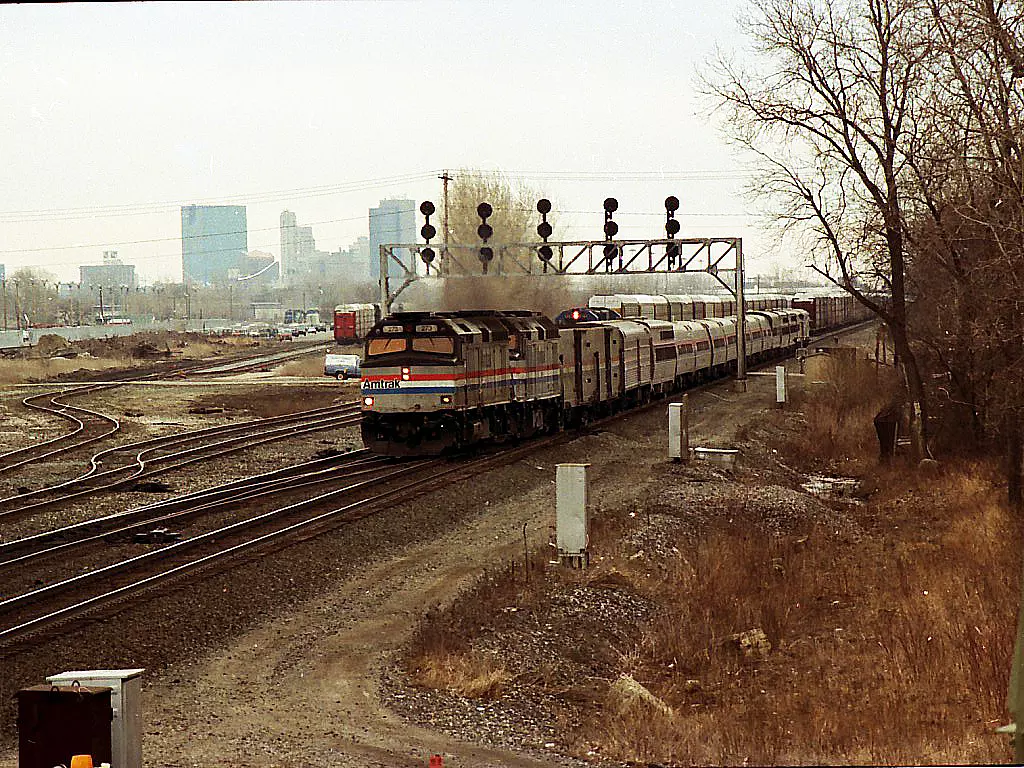 Amtrak and freight trains side by side, Photo 18
Amtrak and freight trains side by side, Photo 18
After traffic finally cleared, the multi-level engine was able to back down to his train and make brake test, but because of the headroom problem he was delayed 45 minutes. This move required the engine to go west out of the interlocking before backing to the train because otherwise switch 27 could not be reversed.
The Drag Race
Nasby is a great spot to watch westbound trains accelerate, even though the speed limit through the diamonds is 50 mph (Photo 19). Heavy trains coming from CP-289 are still accelerating when they reach Nasby. Many trains change crews at Toledo, usually at the Union Station CP-288, and so have been stopped before heading west.
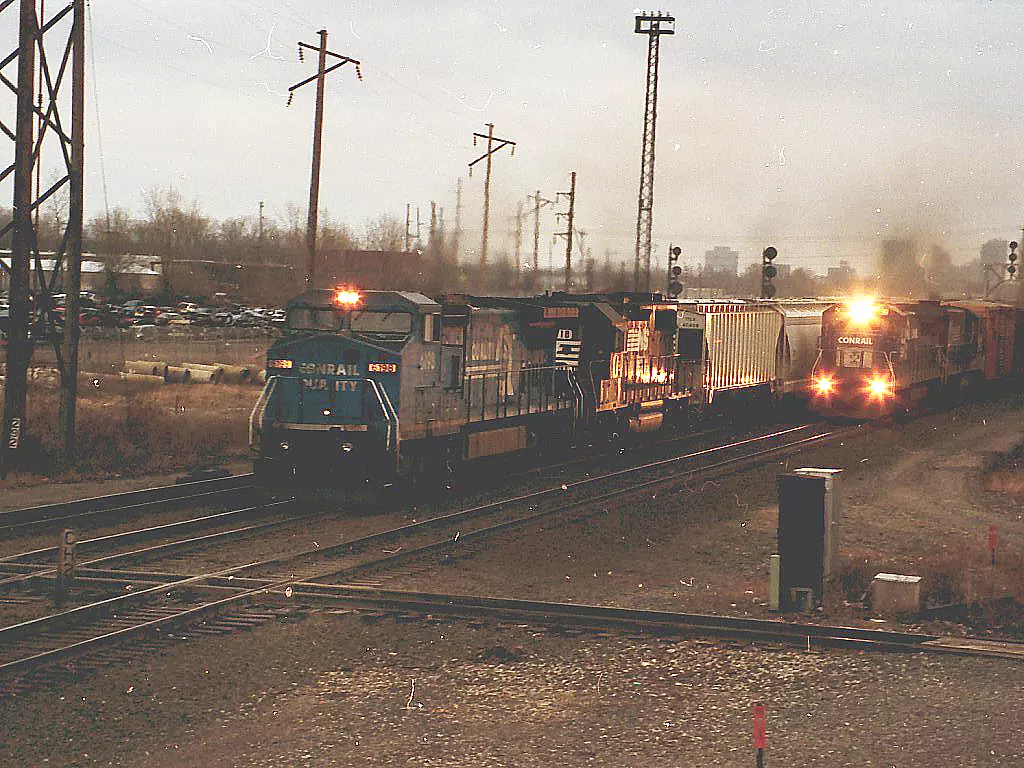 Trains accelerating beyond the 50 mph speed limit, Photo 19
Trains accelerating beyond the 50 mph speed limit, Photo 19
One evening at dusk the dispatcher happened to start two trains west at about the same time. When they got to Nasby they were almost neck and neck (left. I told a CSX engineer who lives across the street about this and he said with a twinkle in his eye that they would never race.
The Operators and Other Towers
I had met some 15 or so operators at Nasby. I could usually recognize the operator’s voice on the scanner, but fairly often I would hear a new voice. The operator’s existence was anything but predictable. The operators with high seniority could hold a shift for a number of months, but this would always change in April and December when the Great lakes shipping season started and ended. The bridge operators bump in and out of the towers at these times. There were also operators on the extra board for vacation and illness coverage. Several operators commuted from long distances and stayed in motels or apartments as they have gravitated to the few towers still open, such as here in Toledo. The high seniority operators were hoping to hang on for retirement. Younger operators were hoping for a New York Dock settlement when the Conrail split-up occurred. Two young operators had been accepted for dispatcher training in Dearborn.
The closing of Alexis Tower July 1998 forced four operators to bump to Nasby and the other towers. Conrail had Stanley Tower at the north end of Stanley Yard at the Toledo Terminal crossing and the Walbridge tower. This tower is on a remnant of the Pennys and controls moves from the CSX Walbridge Yard northward on the Toledo Terminal. Walbridge Tower has rarer pneumatic switches instead of electric.
The Stanley Tower (now CSX is the most complex of the Toledo towers with over 100 levers.
All other images and commentary are courtesy of John Ehrmin.

